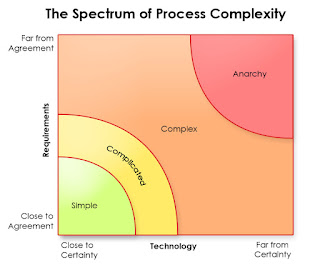A few words about the different kind of systems, just so you know in which kind of trouble you are when you start gathering requirements :-)
SIMPLE
What it is: you can see clearly all the connections between cause and effect .
How to handle it: it is usually easy.
COMPLICATED
What it is: there are cause - effect connections, but it's not easy to see them. There is never a unique solution.
How to handle it: ask questions to the experts (if there is any).
COMPLEX
What it is: it is made of many pieces, and they are highly interconnected. The output is usually part of the system itself and influences it, so it's difficult even to ask yourself the right questions.
How to handle it: test some small parts and see what it happens (someone calls it "dance with the system.")
CHAOS
What it is: high uncertainty, no apparent cause and effect and ... when some rule seem to apply, it will probably change very rapidly.
How to handle it: run away !
SIMPLE
What it is: you can see clearly all the connections between cause and effect .
How to handle it: it is usually easy.
COMPLICATED
What it is: there are cause - effect connections, but it's not easy to see them. There is never a unique solution.
How to handle it: ask questions to the experts (if there is any).
COMPLEX
What it is: it is made of many pieces, and they are highly interconnected. The output is usually part of the system itself and influences it, so it's difficult even to ask yourself the right questions.
How to handle it: test some small parts and see what it happens (someone calls it "dance with the system.")
CHAOS
What it is: high uncertainty, no apparent cause and effect and ... when some rule seem to apply, it will probably change very rapidly.
How to handle it: run away !

Comments
Post a Comment